GENERAL ELECTRIC GDWT260RSS, GDWT200RWW User Manual

Dishwashers
GEAppliances.com
Safety Instructions . . . . . . . . |
. . . 2–5 |
Owner’s Manual |
Operating Instructions |
|
Stainless Steel |
Care and Cleaning . . . . . . . . . . . . . |
. . . . 17 |
Tub Dishwashers |
Control Panel and Settings . . . . . . |
. . 6–9 |
|
Display Lights . . . . . . . . . . . . . . . . . . |
. . . . . 9 |
|
Loading Place Settings . . . . . . . . . . |
. . . 16 |
|
Loading the Racks . . . . . . . . . . . . . |
14–16 |
|
Recommended Dishwasher |
|
|
Products . . . . . . . . . . . . . . . . . . . . . . . . |
. . . . .9 |
|
Using the Dishwasher . . . . . . . . . . |
10–13 |
|
Troubleshooting Tips . . . . . . 18–20
Consumer Support
Consumer Support . . . . . . . . . . . . . . . . .25
Warranty . . . . . . . . . . . . . . . . . . . . . . . . . . 24
Write the model and serial numbers here:
Model # __________________
Serial # __________________
You can find them on the tub wall just inside the door.
165D4700P389 49-55065 07-09 JR
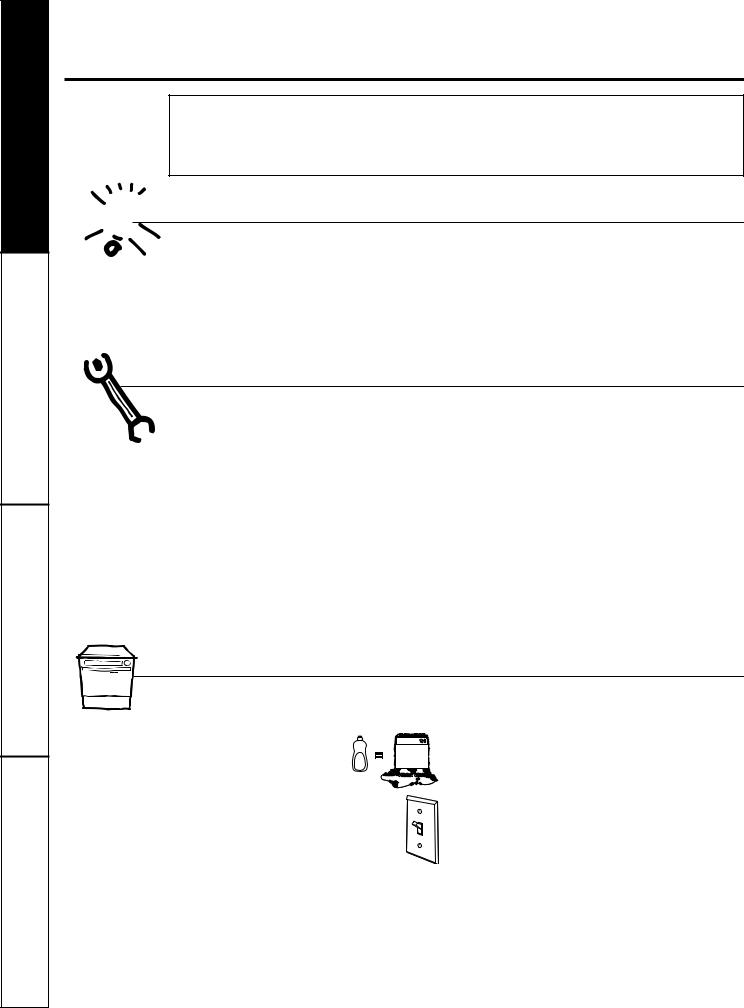
Safety Instructions
Operating Instructions
Troubleshooting Tips
Consumer Support
IMPORTANT SAFETY INFORMATION
READ ALL INSTRUCTIONS BEFORE USING—
SAVE THESE INSTRUCTIONS
 WARNING!
WARNING!
For your safety, the information in this manual must be followed to minimize the risk of fire, explosion, electric shock, and to prevent property damage, personal injury, or death.


 WARNING! WATER HEATER SAFETY
WARNING! WATER HEATER SAFETY
Under certain conditions, hydrogen gas may be produced in a water heater that has not been used for two or more weeks. HYDROGEN GAS IS EXPLOSIVE.
If the hot water has not been used for two or more weeks, prevent the possibility of damage or injury by turning on all hot water faucets and allow them to run for several minutes. Do this before using any electrical appliance connected to the hot water system. This simple procedure will allow any built-up
hydrogen gas to escape. Since the gas is flammable, do not smoke, use an open flame, or use the appliance during this process.
PROPER INSTALLATION AND MAINTENANCE
This dishwasher must be properly installed and located in accordance with the Installation Instructions before it is used. If you did not receive an Installation Instructions sheet with your dishwasher, you can receive one by visiting our website at GEAppliances.com.
■Connect the dishwasher/appliance to a grounded metal, permanent wiring system; or run an equipment-grounding conductor with the circuit conductors and connect to the equipmentgrounding terminal or lead of the appliance.
■Improper connection of the equipment-grounding conductor can result in a risk of electric shock. Check with a qualified electrician or service representative if you are in doubt whether the appliance is properly grounded.
■Dispose of discarded appliances and shipping or packing material properly.
■Do not attempt to repair or replace any part of your dishwasher unless it is specifically
recommended in this manual. All other servicing should be referred to a qualified technician.
■To minimize the possibility of electric shock, disconnect this appliance from the power supply before attempting any maintenance.
NOTE: Turning the dishwasher off does not disconnect the appliance from the power supply. We recommend having a qualified technician service your appliance.
 CAUTION: To prevent minor injury and property damage
CAUTION: To prevent minor injury and property damage
■Contents washed in Anti-bacterial mode, if available, may be hot to the touch. Use care before handling.
■Using a detergent that is not specifically designed for dishwashers will cause the dishwasher to fill with suds.
■If your dishwasher is connected to a wall switch, ensure that the switch is on prior
to use.
■On dishwashers with electronic controls, if you choose to turn the wall switch
off between wash cycles, allow 5-10 seconds after turning the switch on before touching START/RESET to allow the control to initialize.
■Non-Dishware Items: Do not wash items such as electronic air cleaner filters, furnace filters and paint brushes in your dishwasher. Damage to the dishwasher and discoloration or staining of the dishwasher may result.
■Close supervision is necessary if this appliance is used by or near children.
■Load light, plastic items so they do not become dislodged and drop to the bottom of the dishwasher—they might come into contact with the heating element and be damaged.
2
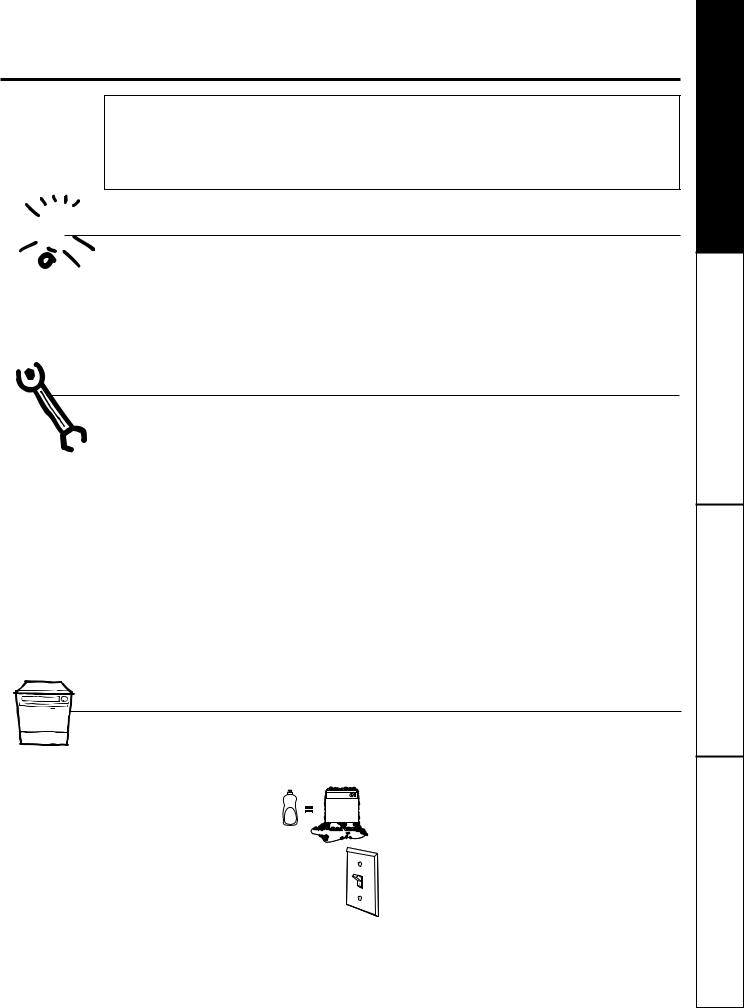
INFORMACIÓN IMPORTANTE DE SEGURIDAD |
|
LEA TODAS LAS INSTRUCCIONES ANTES DE USAR— |
|
GUARDE ESTAS INSTRUCCIONES |
GEAppliances.com |
 ¡ADVERTENCIA!
¡ADVERTENCIA!
Para su seguridad, debe cumplirse con la información de este manual a fin de minimizar el riesgo de incendio o explosión, descarga eléctrica o para prevenir daños a la propiedad, lesiones personales o la muerte.


 ¡ADVERTENCIA! SEGURIDAD DEL CALENTADOR DE AGUA
¡ADVERTENCIA! SEGURIDAD DEL CALENTADOR DE AGUA
Bajo ciertas condiciones, puede producirse gas de hidrógeno en un calentador de agua que no se ha usado durante dos semanas o más. EL GAS DE HIDRÓGENO ES EXPLOSIVO.
Si el agua caliente no se ha utilizado por dos semanas o más, evite la posibilidad de daños o lesiones abriendo todos los grifos de agua caliente y dejándolas correr durante varios minutos. Haga esto antes
de utilizar cualquier aparato eléctrico que se encuentre conectado al sistema de agua caliente. Este simple procedimiento permitirá que se libere cualquier clase de acumulación de gas de hidrógeno. Ya que el gas es inflamable, no fume o utilice una llama abierta o un aparato durante este proceso.
INSTALACIÓN Y MANTENIMIENTO ADECUADOS
Este lavaplatos debe instalarse de manera adecuada y ubicarse de acuerdo con las Instrucciones de Instalación antes de comenzar el uso. Si usted no ha recibido una página de Instrucciones de instalación con su lavaplatos, puede obtener una visitando nuestro sitio Web en GEAppliances.com.
■Conecte el lavaplatos/aparato a un sistema
de cableado permanente con conexión a tierra
o debe utilizarse un conductor de conexión a tierra del equipamiento con los conductores de circuito, y debe conectarse a la terminal de conexión
a tierra o conductor del aparato.
■Una conexión inadecuada del conductor de conexión a tierra de equipo puede provocar un riesgo de descarga eléctrica. Consulte a un
electricista calificado o representante de servicio técnico si tiene dudas sobre la correcta conexión a tierra del aparato.
■Elimine los aparatos que no va a utilizar más y el material de empaque o envío como corresponde.
■No intente reparar o cambiar ninguna pieza de su lavaplatos a menos que esté específicamente recomendado en este manual. Cualquier otro servicio debe realizarlo un técnico calificado.
■Para minimizar la posibilidad de una descarga eléctrica, desconecte este aparato de la fuente de energía antes de realizar cualquier clase de mantenimiento.
NOTA: Apagar el lavaplatos no desconecta el aparato del suministro de energía. Recomendamos que un técnico calificado realice el servicio técnico de su aparato.
 PRECAUCIÓN: Para evitar lesiones menores y daños a la propiedad
PRECAUCIÓN: Para evitar lesiones menores y daños a la propiedad
■Los elementos lavados en el modo anti-bacterial, si se encuentra disponible, pueden quedar calientes al tacto. Tenga cuidado antes de tocarlos.
■Utilizar un detergente no diseñado específicamente para lavaplatos provocará que el aparato se llene de espuma.
■Si su lavaplatos se encuentra conectado a un interruptor de pared, verifique que el interruptor se encuentre encendido antes del uso.
■En lavaplatos con controles electrónicos, si usted elije apagar el interruptor de pared entre ciclos de lavado, deje pasar 5-10 segundos después de encender el interruptor antes de presionar START/RESET para permitir que el control se inicie.
■Elementos no aptos para lavaplatos: No lave elementos como filtros de limpiadores de aire electrónicos, filtros de hornos y pinceles de pintura en su lavaplatos. Pueden producirse daños en el lavaplatos y decoloración o manchas en el aparato.
■Se requiere una supervisión estricta cuando cualquier aparato es utilizado por niños o en su cercanía.
■Cargue elementos livianos y plásticos de modo que no se desplacen y caigan al fondo del lavaplatos, ya que pueden entrar en contacto con el elemento calentador y dañarse.
3
Instructions Safety
Instructions Operating
Tips Troubleshooting
Support Consumer
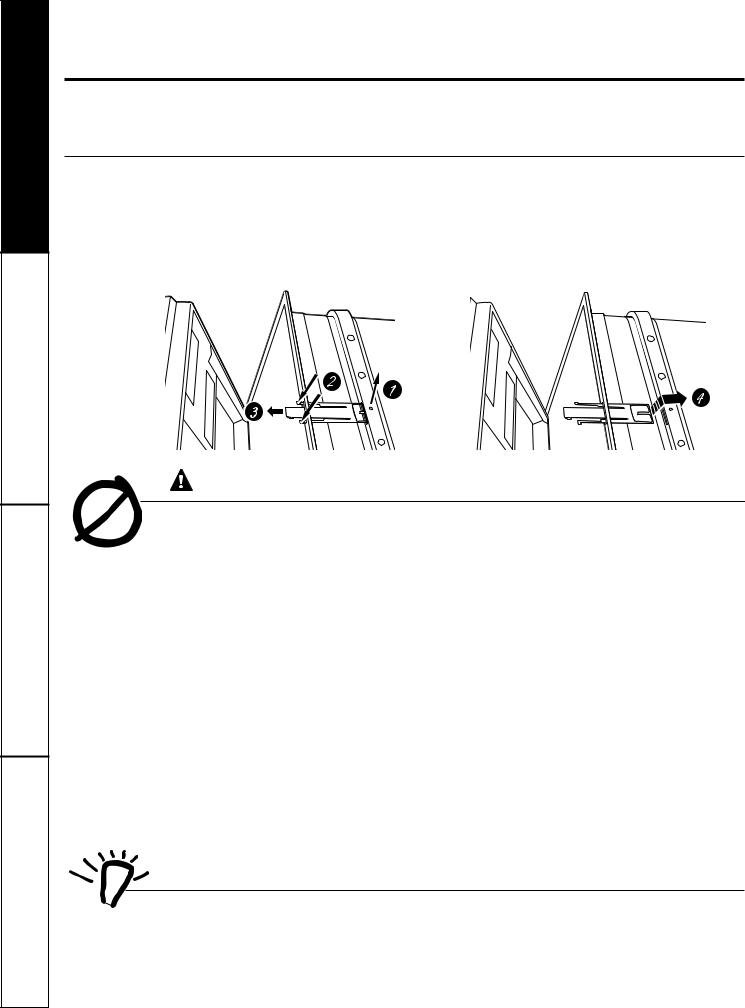
Safety Instructions
Operating Instructions
Troubleshooting Tips
Consumer Support
IMPORTANT SAFETY INFORMATION
READ ALL INSTRUCTIONS BEFORE USING— SAVE THESE INSTRUCTIONS
 WARNING! RISK OF CHILD ENTRAPMENT
WARNING! RISK OF CHILD ENTRAPMENT
PROPER DISPOSAL OF THE DISHWASHER
Junked or abandoned dishwashers are dangerous…even if they will sit for “just a few days.” If you are getting rid of your old dishwasher, please follow the instructions below to help prevent accidents.
Before You Throw Away Your Old
Dishwasher:
■Take off the door of the washing compartment or remove the door latch (as shown).
NOTE: All top control models also have a latch screw which must be removed (Step 1) as shown.
Screw
(on some models)
WARNING! When using your dishwasher, follow basic precautions, including the following:
■Use this appliance only for its intended purpose as described in this Owner’s Manual.
■Use only powder, tabs, liquid detergents or rinse agents recommended for use in a dishwasher and keep them out of the reach of children.
Cascade® and Cascade® Complete Automatic Dishwashing Detergents, and Cascade Crystal Clear® rinse agents have been approved for use in all GE dishwashers.
■On models with the SmartDispense™ system, do not mix any chlorine bleach-based automatic dishwashing detergent with any dishwashing detergent containing enzymes as this could cause the detergents to congeal and lead to blockage of the SmartDispenseTM system.
■Locate sharp items so that they are not likely to damage the door seal.
■Load sharp knives with the handles up to reduce the risk of cut-type injuries.
■Do not wash plastic items unless marked dishwasher safe or the equivalent. For plastic
items not so marked, check the manufacturer’s recommendations.
■Do not touch the heating element during or immediately after use.
■Do not operate your dishwasher unless all enclosure panels are properly in place.
■Do not tamper with controls.
■Do not abuse, sit on or stand on the door or dish rack of the dishwasher.
■Do not allow children to play around the dishwasher when opening or closing the door due to the possibility of small fingers being pinched in the door.
■Do not discard a dishwasher without first removing the door of the washing compartment or the door latch.
■Do not store or use combustible materials, gasoline or other flammable vapors and liquids in the vicinity of this or any other appliance.
■Do not allow children to play with, on or inside this or any discarded appliance.
READ AND FOLLOW THIS SAFETY INFORMATION CAREFULLY.


 SAVE THESE INSTRUCTIONS
SAVE THESE INSTRUCTIONS
4

INFORMACIÓN IMPORTANTE DE SEGURIDAD |
|
LEA TODAS LAS INSTRUCCIONES ANTES DE USAR— |
|
GUARDE ESTAS INSTRUCCIONES |
GEAppliances.com |
 ¡ADVERTENCIA! RIESGO DE ENCIERRO PARA NIÑOS
¡ADVERTENCIA! RIESGO DE ENCIERRO PARA NIÑOS
ELIMINACIÓN CORRECTA DEL LAVAPLATOS
Un lavaplatos desechado o abandonado resulta peligroso…aún si quedará en un lugar por “sólo unos días”. Si va a desechar su viejo lavaplatos, siga las siguientes instrucciones para prevenir accidentes.
Antes de desechar su viejo lavaplatos:
■Quite la puerta del compartimento de lavado o saque la traba de la puerta (como puede verse).
NOTA: Todos los modelos con control superior también cuentan con un tornillo de la traba que debe quitarse (Paso 1) como se ilustra.
Tornillo
(en algunos modelos)
¡ADVERTENCIA! Cuando use su lavaplatos, siga precauciones básicas
de seguridad, incluyendo las siguientes:
■Use este aparato sólo con el objetivo para el que fue creado, como se describe en este Manual del Propietario.
■Utilice sólo detergentes en polvo, líquido o tabletas o agentes de enjuague recomendados para uso en lavaplatos y manténgalos alejados del alcance de los niños. Los detergentes para lavaplatos automáticos Cascade® y Cascade® Complete,
y los agentes de enjuague Cascade Crystal Clear® han sido aprobados para el uso en todos los lavaplatos GE.
■En modelos con el sistema SmartDispense™, no mezcle detergentes para lavaplatos automáticos con blanqueador con detergentes para lavaplatos que contengan enzimas porque los detergentes pueden solidificarse y provocar bloqueos en el sistema SmartDispense™.
■Ubique los elementos filosos de modo que no dañen el sellado de la puerta.
■Cargue cuchillos filosos con los mangos hacia arriba para reducir el riesgo de una lesión personal.
■No lave elementos plásticos a menos que estén marcados como aptos para lavaplatos o
equivalente. En el caso de elementos plásticos que no estén marcados así, verifique las recomendaciones del fabricante.
■No toque el elemento calentador durante el uso o inmediatamente después de finalizar el uso.
■No haga funcionar el lavaplatos a menos que todos los paneles del recinto se encuentren en su lugar.
■No altere o modifique los controles.
■No maltrate, ni se siente o se pare sobre la puerta o bandejas de los platos del lavaplatos.
■No permita que los niños jueguen alrededor del lavaplatos cuando abra o cierre la puerta debido
a la posibilidad de pellizcar sus dedos con la puerta.
■No deseche el lavaplatos sin antes quitar la puerta del compartimento de lavado o la traba de la puerta.
■No almacene o use materiales combustibles, gasolina u otros vapores o líquidos inflamables cerca de este o cualquier otro aparato.
■No permita que los niños jueguen sobre, con o dentro de este o cualquier otro aparato desechado.
LEA Y SIGA ESTA INFORMACIÓN DE SEGURIDAD CUIDADOSAMENTE.


 GUARDE ESTAS INSTRUCCIONES
GUARDE ESTAS INSTRUCCIONES
5
Instructions Safety
Instructions Operating
Tips Troubleshooting
Support Consumer
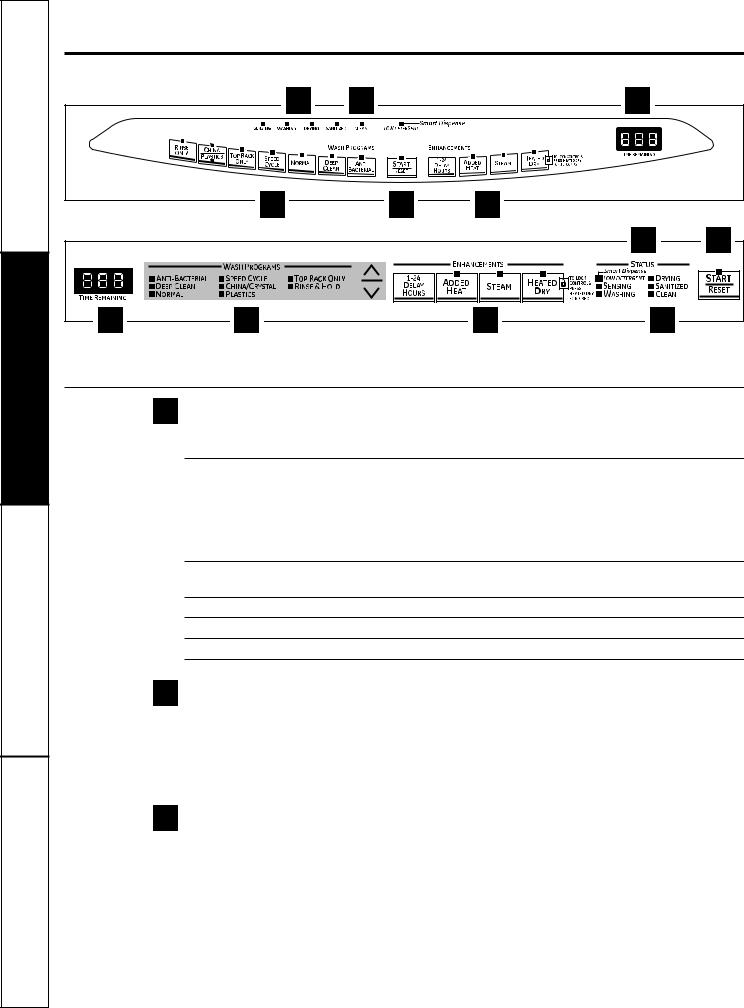
Safety Instructions
Operating Instructions
Troubleshooting Tips
Consumer Support
About the dishwasher control panel.
You can locate your model number on the tub wall just inside the door. Throughout this manual, features and appearance may vary from your model.
Front-Control Dishwashers |
1 |
6 |
|
2 |
|
3 |
|
5 |
4 |
Top-Control Dishwashers |
1 |
5 |
|
2 3 4 6
Control Settings
1 Status Indicator Lights(Indicators vary by models)
The Status display tells you what is happening while the dishwasher is in operation and may flash, indicating a malfunction. The lights will come ON indicating the sequence of the dishwasher operation.
LOW DETERGENT Displayed when the SmartDispenseTM needs to be refilled with liquid or gel automatic dishwasher detergent.
NOTE: If you are not using SmartDispenseTM and you want to turn the LOW DETERGENT LED light off, press the ADDED HEAT pad 5 times within 3 seconds. You will hear 3 beeps; then the light will go off. You can turn the light back on by pressing the ADDED HEAT pad 5 times within 3 seconds.
SENSING Displayed while the Clean SensorTM is measuring the amount of soil and temperature of water. The dishwasher will adjust the selected cycle to achieve optimal performance.
WASHING Displayed during prewash, main wash and rinse periods.
DRYING Displayed during HEATED DRY.
SANITIZED Displayed when cycle has met sanitization conditions.
CLEAN Displayed when a wash cycle is complete.
2 Time Remaining Display (on some models)
During operation, the display shows the minutes remaining until the cycle is complete. The display may adjust the remaining time while the Sensing light is on. The time displayed at the start of each cycle may change from the factory setting as the unit customizes itself to home use. During a delay start, the display will show hours of time remaining until the cycle starts.
NOTE: This dishwasher is equipped with CleanSensorTM with automatic temperature control; therefore, cycle length and time may vary depending on soil and water temperature conditions.
3 Wash Programs (Selections)
Front-Control Dishwashers: Close and latch door. Press the pad for the desired wash cycle.
Top-Control Dishwashers: Use the arrow pads  to scroll through the wash cycles while door is open.
to scroll through the wash cycles while door is open.
NOTE: All cycle times and water usage information contained in the following section are approximate values. Actual results will depend on several factors, including but not limited to inlet temperature
and amount of soil in the wash water.
The light above or next to the selected pad will be ON to indicate which WASHCYCLEhas been selected.
6

GEAppliances.com
3 Wash Programs (Selections) (continued)
ANTI-BACTERIAL/ |
7.5–8.75 gal., 50–135 min. |
||
|
|
SANI WASH |
This cycle raises the water temperature in the final rinse to sanitize your dishware. |
|
|
|
|
|
|
|
The cycle length will vary depending on the temperature of your inlet water. |
|
|
|
NOTE: The Anti-Bacterial cycle is monitored for sanitization requirements. If the cycle is |
|
|
|
interrupted during or after the main wash portion or if the incoming water temperature |
|
|
|
is so low that adequate water heating cannot be achieved, the sanitizing conditions may |
|
|
|
not be met. In these cases, the sanitized light will not illuminate at the end of the cycle. |
|
|
|
When using the Anti-Bacterial cycle, do not open the dishwasher door in the final rinse. |
|
|
|
NOTE: NSF-certified residential dishwashers are not intended for licensed food |
|
|
|
establishments. |
|
|
|
NOTE: Only the Anti-Bacterial cycle has been designed to meet the requirements |
|
|
|
of Section 6, NSF 184 for soil removal and sanitization efficacy. |
|
|
DEEP CLEAN |
10 gal., 115–135 min. |
(on some models) |
This cycle is meant for heavily soiled dishes or cookware with dried-on or baked-on soils. |
||
|
|
|
This cycle may not remove burned-on foods. Everyday dishes are safe to be used in this |
|
|
|
cycle. |
|
|
|
NOTE: On some models, the STEAM enhancement will be automatically selected when |
|
|
|
the DEEPCLEAN cycle is chosen, and cannot be de-selected. |
|
|
COOKWARE/ |
8.75–10 gal., 75–140 min. |
|
|
POTS & PANS |
This cycle is meant for heavily soiled dishes or cookware with dried-on or baked-on soils. |
(on some models) |
This cycle may not remove burned-on foods. Everyday dishes are safe to be used in |
||
|
|
|
this cycle. |
|
|
NORMAL WASH |
5.2 gal., 60–90 min. |
|
|
|
This cycle is for medium/heavily soiled dishes and glassware. |
|
|
|
Cycle time and water usage are approximate values. Results will depend on |
|
|
|
several factors, including but not limited to inlet temperature, household water |
|
|
|
pressure and amount of soil in the wash water. |
|
|
|
|
|
|
SPEED CYCLE |
7.5 gal., 35–70 min. |
(on some models) |
This cycle is for everyday dishes and glassware. |
||
|
|
|
|
|
CHINA/CRYSTAL |
7.5 gal., 40–60 min. |
|
|
|
LIGHT WASH |
This cycle is for lightly soiled china and crystal. |
(on some models) |
NOTE: On some models, this cycle and PLASTICS selector is a toggle pad; push pad |
||
|
|
|
|
|
|
|
to switch between this cycle and PLASTICS. |
|
|
|
|
|
|
GLASSES |
7.5 gal., 40–75 min. |
(on some models) |
This cycle is specifically designed for glasses. |
||
|
|
|
|
|
|
PLASTICS |
6.25–7.5 gal., 85–145 min. |
(on some models) |
The longer time for this cycle includes a built-in drying portion that is specifically |
||
|
|
|
|
|
|
|
designed to reduce the risk of melting plastic items and improve plastic drying. |
|
|
|
|
|
TOP RACK ONLY |
5–8.75 gal., 50–110 min. |
|
(on some models) |
This cycle washes lightly soiled dishes on the upper rack only. |
||
|
|
|
|
|
|
|
|
RINSE AND HOLD |
2.5 gal., 11 min. |
||
|
|
(RINSE ONLY) |
For rinsing partial loads that will be washed later. Do not use detergent with this cycle. |
7
Instructions Safety
Instructions Operating
Tips Troubleshooting
Support Consumer

Safety Instructions
Operating Instructions
Troubleshooting Tips
Consumer Support
About the dishwasher control panel.
4 Enhancements
The light above the selected pad will be ON to indicate which ENHANCEMENT has been selected.
DELAY HOURS You can delay the start of a wash cycle for up to 24 hours (depending on model).
Press the DELAY START pad to choose the number of hours you want to delay the start of the cycle; then press START/RESET.
Front-Control Dishwashers: The machine will count down and start automatically at the correct time.
Top-Control Dishwashers: After closing the door, the machine will count down and automatically start at the correct time.
NOTE: To cancel the DELAY START selection before the cycle begins, repeatedly press the DELAY START pad until the display is blank.
TEMP BOOST/ When selected, the cycle will run longer with heating element on to improve both wash ADDED HEAT/ and dry performance.
EXTRA HOT WASH NOTE: Cannot be selected with RINSE AND HOLD cycle.
STEAM For use with heavily soiled and/or dried-on, baked-on soils. This option MUST be (on some models) selected PRIOR to starting the cycle. The STEAM option adds 26 minutes to the
cycle time.
NOTE: Cannot be selected with RINSE AND HOLD cycle.
HEATED DRY When HEATED DRY is off, dishes will air dry. Top-control models have a fan that assists the drying process. The fan will run up to 4 hours after the CLEAN light illuminates. If desired, pressing any keypad will turn off the fan.
Light Off: Shuts off the drying heat option. Dishes will air dry naturally (front-control dishwashers) or fan dry (top-control dishwashers) to save energy.
Light On: Turns the heater on for faster drying. This will extend the total cycle time between 8 and 38 minutes depending on the cycle selected. On top-control models, a fan will continue to run up to 2 hours after the CLEAN light illuminates to assist the drying process. If desired, pressing any keypad will turn off the fan.
NOTE: Cannot be selected with RINSE AND HOLD cycle.
LOCK You can lock the controls to prevent any selections from being made. Or you can lock
the controls after you have started a cycle.
Children cannot accidentally start dishwasher by touching pads with this option selected.
To unlock the dishwasher controls, press and hold the HEATED DRY pad for 3 seconds. The light above the lock pad will turn off. To lock the dishwasher, press and hold the HEATED DRY pad for 3 seconds. The light above the LOCK pad will turn on.
RESET To change a cycle after washing starts…
Front-Control Dishwashers: Touch the START/RESET pad to cancel the cycle.
The START/RESETlight will flash while the water is pumped out if needed. This takes approximately 2 minutes.
Top-Control Dishwashers:Open the door slowly to prevent splash-out.
Touch the START/RESET pad to cancel the cycle. If the START/RESET light is flashing, close the door until the water pumps out (this takes approximately 2 minutes)
and the light stops flashing.
When the light stops flashing, the dishwasher can be reprogrammed and restarted.
5 Start
Front-Control Dishwashers
Close and latch the dishwasher door and select the cycle and desired enhancements. Touch the START/RESET pad one time to begin the cycle. Water fill begins immediately, and approximately 60 seconds later the wash action begins.
When the dishwasher door is fully closed and latched, the control panel lights will display the last settings you selected. If you don’t want to change any of the settings, simply touch the START/RESET pad to begin the cycle.
If the door is closed, the indicator lights will turn off if the START/RESET pad is not selected within 5 minutes.
To activate the display, open and close the door or press any pad.
8

GEAppliances.com
5 Start (continued)
Top-Control Dishwashers
After selecting the cycle and desired enhancements, touch the START/RESET pad to ready the dishwasher to begin the cycle. Close the door to start the cycle or begin the DELAY START countdown. When the cycle starts, the water fill begins and approximately 60 seconds later the wash action begins.
The dishwasher will always display your last selection and enhancements. If you don’t want to change the settings, simply touch the START/RESET pad to ready the dishwasher and close the door to begin the cycle.
ALL MODELS: If a power failure occurs NORMAL and HEATED DRY will automatically be programmed. Make any new selections and touch the START/RESET pad to begin the new cycle.
When the door is opened, the indicator lights will turn off if the START/RESET pad is not selected within 5 minutes. To activate the display, open and close the door or touch any pad.
6 Clean
Front-Control Dishwasher
The CLEAN light will illuminate and a double beep will sound when a wash cycle is complete. On some models, the CLEAN light will turn off when the door is opened. On other models, the CLEAN light will remain on until the door is opened and then relatched or until any keypad is pressed while the door
is latched shut.
Top-Control Dishwasher
The CLEAN light will illuminate and a double beep will sound when a wash cycle is complete. The CLEAN light will remain on until the door is opened and then relatched or until any key is pressed.
ALL MODELS: To turn off the audible end-of-cycle signal (or re-activate it if it was previously turned off), press the HEATED DRY pad 5 times within 3 seconds. A triple beep will sound to indicate the end-of-cycle beep option has been toggled.
Flashing display lights.
Status Indicator Lights |
What It Means |
START/RESET |
Cycle has been interrupted by pressing the START/RESET pad, or there |
|
has been a power failure. Light will stop flashing after the dishwasher |
|
automatically drains out the water. The dishwasher will restart with NORMAL |
|
and HEATED DRY if the interruption was the result of a power failure. |
Recommended dishwasher products.
GE recommends the following products for use in its dishwashers:
■For your manual detergent dispenser, Cascade® powder, liquid or gel automatic dishwasher detergents are approved.
■For your SmartDispenseTM Detergent Dispenser, use only the recommended liquid automatic detergents listed on page 12 of this manual.
■Cascade Crystal Clear® rinse agents to remove spots and prevent new film buildup on your dishes, glasses, flatware, cookware and plastic. Using rinse agent also improves dry performance.
■Cerama Bryte® Stainless Steel Appliance Cleaner to clean the exterior stainless steel panel of GE and ProfileTM dishwashers (for stainless steel exterior models only).
9
Instructions Safety
Instructions Operating
Tips Troubleshooting
Support Consumer
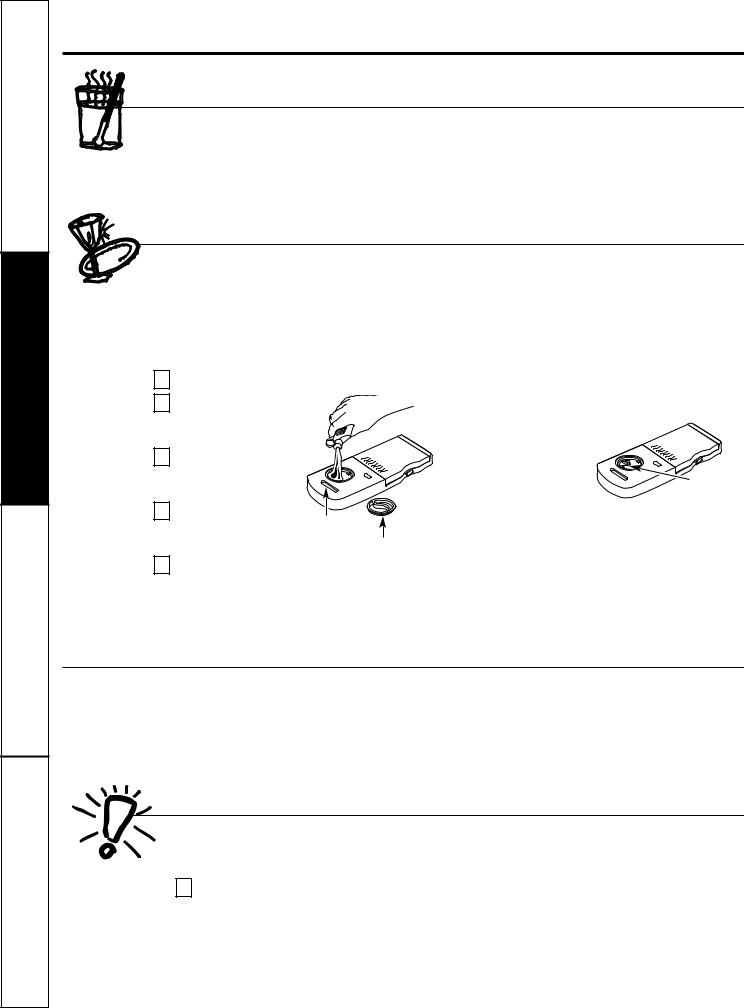
Safety Instructions
Operating Instructions
Troubleshooting Tips
Consumer Support
Using the dishwasher.
Check the Water Temperature
The entering water should be at least 120°F and not more than 150°F for effective cleaning and to prevent dish damage. Check the water temperature with a candy or meat thermometer. Turn on the hot water faucet nearest the dishwasher, place the thermometer in a glass and let the water run continuously into the glass until the temperature stops rising.
Use Cascade Crystal Clear® Rinse Agent
Cascade Crystal Clear® rinse agent improves drying, removes spots and prevents new film buildup on your dishes, glasses, flatware, cookware and plastic.
Filling the Dispenser
The rinse agent dispenser holds 3.5 oz. of rinse agent. Under normal conditions, this will last approximately one month. Try to keep it full, but do not overfill.
1 |
Make sure the dishwasher door is fully open. |
|
2 |
Turn the dispenser |
|
|
cap to the left and |
|
|
lift it out. |
|
3 |
Add rinse agent until |
|
|
the indicator window |
|
|
looks full. |
|
4 |
Clean up any spilled |
Indicator |
|
rinse agent with a |
|
|
damp cloth. |
window |
|
Dispenser cap |
|
5 |
Replace the dispenser cap. |
|
Rinse Aid Setting
The amount of rinse agent released into the final wash can be adjusted. The factory setting is at the midpoint. If there are rings of calcium (hard water) spots on dishes, try a higher setting. If there is foaming, use a lower setting.
To adjust the setting: |
|
|
Remove the dispenser cap; |
|
|
then turn the adjuster |
|
|
counterclockwise to |
|
|
increase the amount |
Rinse agent |
|
of rinse agent or |
||
adjuster |
||
clockwise to reduce |
|
|
the amount of rinse agent dispensed. |
|
Dish Preparation Prior to Loading
■ No prerinsing of normal food soil is required. |
■ Remove large quantities of any remaining food. |
■ Scrape off hard soils, bones, toothpicks, skins and |
■ Remove leafy vegetables, meat trimmings and |
seeds. |
excessive amounts of grease or oil. |
Forget to Add a Dish?
A forgotten dish can be added any time before |
|
Add forgotten dishes. |
||
3 |
||||
the main wash. |
|
Close the door and dishwasher will start |
||
|
||||
|
|
Squeeze the door latch to release the door. |
4 |
|
|
1 |
|
in 5 seconds. |
|
|
||||
2Do not open the door until the water spray action stops. Steam may rise out of the dishwasher.
10
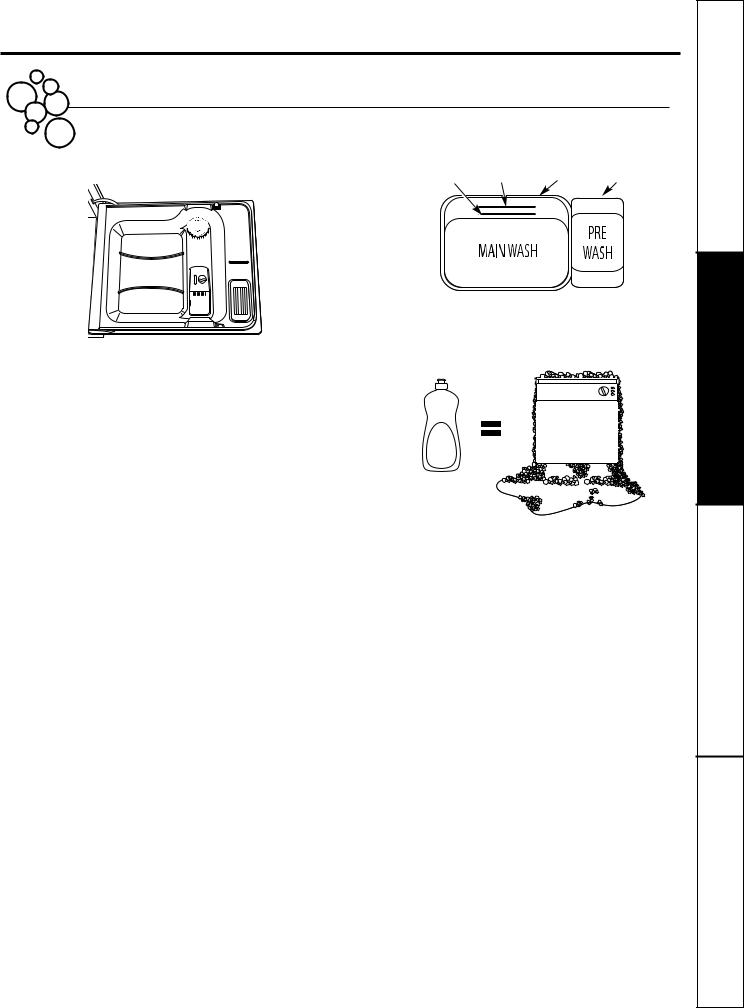
GEAppliances.com
Manual Detergent Dispenser
Some models come equipped with an automatic liquid dishwasher detergent dispenser (SmartDispenseTM) and
a manual dispenser. You can use either of these dispensers but don’t use both at the same time.

 SmartDispenseTM
SmartDispenseTM
For heavily soiled loads, use a bit more detergent. For water temperatures above 140°F, use a bit less detergent.
|
Medium |
Medium |
Extremely |
Soft |
Soft |
Hard |
Hard |
 Manual Detergent
Manual Detergent
Dispenser
The cover of the manual dispenser will open during the wash cycle. If you are using SmartDispenseTM, leave the cover of the manual dispenser open before starting the cycle.
For the manual dispenser, Cascade® Automatic Dishwashing Detergents have been approved. You may use powder, liquid, gel packets or tablets in this dispenser. It is important to keep powdered detergents and tablets fresh and dry so they don’t lose effectiveness. Therefore, do not put detergent into the manual dispenser until you are ready to wash dishes.
Filling Manual Detergent Dispenser
The amount of detergent to use depends on whether your water is hard or soft. With hard water, you need extra detergent. With soft water, you need less detergent.
Protect your dishes and dishwasher by contacting your water department and asking how hard your water is. Twelve or more grains is extremely hard water. A water softener is recommended. Without it, lime can build up in the water valve, which could stick while open and cause flooding. Too much detergent with soft water can cause a permanent cloudiness of glassware, called etching.
Use the information in the table below as a guide to determine the amount of automatic dishwasher detergent to place in the dispenser.
When using automatic dishwashing detergent packets or tablets, simply place one in the main wash section and close the cover.
Number |
|
of Grains |
Detergent Cups to Fill |
|
|
Less than 4 |
Fill cup to soft line (1/3 full) |
|
|
4 to 8 |
Fill cup to medium soft line (2/3 full) |
|
|
8 to 12 |
Fill cup to medium hard line |
|
(completely full) |
|
|
Greater |
Fill both main wash cup |
than 12 |
and pre wash cup |
|
|
For heavily soiled loads, use the Deep Clean or Cookware cycle.
DONOTUSEHANDDISHDETERGENT
NOTE: Using a detergent that is not specifically designed for dishwashers will cause the dishwasher to fill with suds. During operation, these suds will spill out of the dishwasher vents, covering the kitchen floor and making the floor wet.
Because so many detergent containers look alike, store the dishwasher detergent in a separate space from all other cleaners. Show anyone who may use the dishwasher the correct detergent and where it is stored.
While there will be no lasting damage to the dishwasher, your dishes will not get clean using a dishwashing detergent that is not formulated to work with dishwashers.
11
Instructions Safety
Instructions Operating
Tips Troubleshooting
Support Consumer
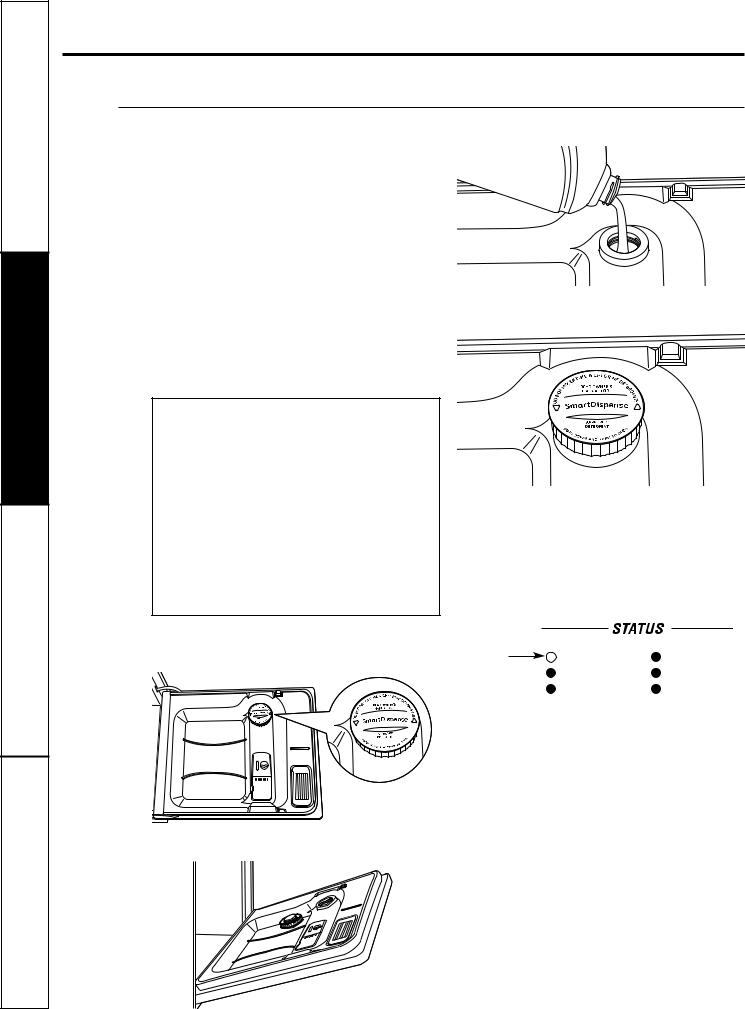
Safety Instructions
Operating Instructions
Troubleshooting Tips
Consumer Support
Using the dishwasher.
SmartDispenseTM Detergent Dispenser (some models)
This dishwasher may have SmartDispenseTM, a feature which automatically dispenses liquid automatic dishwasher detergent into each cycle based on soil level and water hardness. To utilize the SmartDispenseTM Detergent Dispenser, it must first be filled. Although any liquid or gel automatic dishwashing detergent can be used in the SmartDispenseTM system, all liquid or gel automatic dishwashing detergents are not the same. Most automatic dishwashing detergents are chlorine bleach-based (such as Cascade®) while others contain enzymes (such as Cascade Complete®).
Do not mix any chlorine bleach-based automatic dishwashing detergent with any dishwashing detergent containing enzymes as this could cause the detergents to congeal and lead to blockage of the SmartDispenseTM system.
Check the detergent label to determine if the detergent is chlorine bleach-based or one that contains enzymes. It is recommended that the same type of detergent be used when refilling your SmartDispenseTM system.
 CAUTION! Absolutely do not add powder detergent, tablets or any liquid soap or detergent normally used for washing hands or dishes in a sink. Only use liquid or gel detergent specifically designed for use in
CAUTION! Absolutely do not add powder detergent, tablets or any liquid soap or detergent normally used for washing hands or dishes in a sink. Only use liquid or gel detergent specifically designed for use in
an automatic dishwasher.
 ¡PRECAUCIÓN! Bajo ninguna
¡PRECAUCIÓN! Bajo ninguna
circunstancia agregue detergente en polvo, tabletas o jabón o detergente líquido normalmente utilizado para lavar manos o platos en un fregadero. Sólo utilice detergente líquido o en gel específicamente diseñado para utilizar en lavaplatos automáticos.
To open the dispenser for filling, push down and turn the blue cap counterclockwise until the cap is loose. Lift cap off.
Aim the detergent bottle at the opening in the door and begin to fill.
The dispenser will hold 45 oz of liquid dishwasher detergent (standard size bottle).
Turn clockwise.
When full, replace the cap and turn clockwise until tight to ensure no water enters the SmartDispenseTM dispenser. If residue is left on the door, it will be washed off in the next cycle.
An indicator light will turn on to notify you when the dispenser needs to be filled again. After filling, the light will not turn off until the door is closed. A full dispenser will last approximately 1 month for the average user.
SmartDispense
Light Will |
LOW DETERGENT |
DRYING |
|
Turn On |
SENSING |
SANITIZED |
|
When |
WASHING |
CLEAN |
|
Time to |
|||
|
|
||
Refill |
(appearance may vary) |
||
NOTE: If you are not using SmartDispenseTM and you want to turn the LOW DETERGENT LED light off, press the ADDED HEAT pad 5 times within 3 seconds. You will hear 3 beeps; then the light will go off. You can turn the light back on by pressing the ADDED HEAT pad 5 times within 3 seconds.
Set the door at a comfortable angle to fill the dispenser.
12
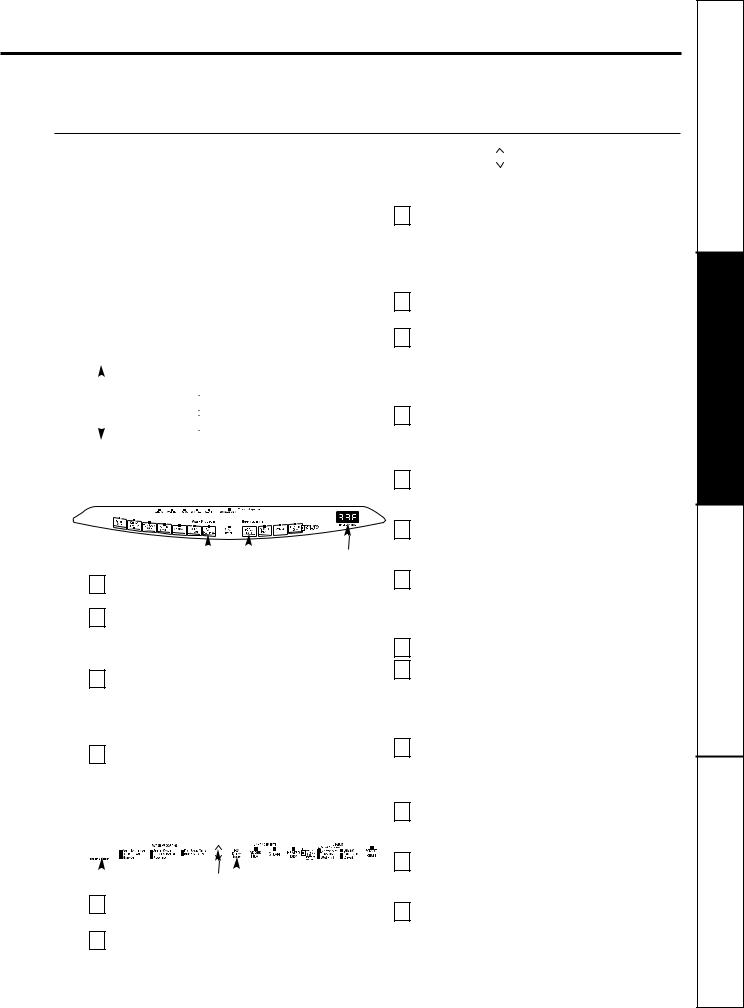
GEAppliances.com
SmartDispenseTM Detergent Dispenser
Water Hardness Calibration
Prior to the first use, the dishwasher needs |
3 |
Press the “Up” |
arrow pad to raise the value |
to be calibrated for water hardness. Please follow |
|
or the “Down” |
arrow pad to lower the value. |
|
|||
the directions below to calibrate the dishwasher |
|
Set the water hardness value to the number |
|
to the hardness of your tap water. |
|
determined with the test strip and table at the left. |
|
Determine the Hardness of Your Tap Water
In the bag that contained these instructions, you should find a water hardness test strip package. Read the instructions on the package, remove the test strip and follow the instructions to determine the hardness level of your tap water. You will use this information to calibrate your dishwasher to dispense the optimal amount of detergent .
Water hardness test strip indication. |
|
Value to Enter |
|||||||||||||
|
|
|
|
|
|
|
|
|
|
|
|
into Dishwasher |
|||
|
SOFT |
|
|
|
|
|
|
|
|
|
|
|
|
|
|
|
|
0 RED |
|
|
|
|
|
|
|
|
|
1 |
|
||
|
|
|
|
|
|
|
|
|
|
|
|
|
|
||
|
|
|
|
|
|
|
|
|
|
|
|
|
|
||
|
|
|
|
1 RED |
|
|
|
|
|
|
|
|
|
2 |
|
|
|
|
|
|
|
|
|
|
|
|
|
|
|
||
|
|
|
|
2 RED |
|
|
|
|
|
|
|
|
|
3 |
|
|
|
|
|
|
|
|
|
|
|
|
|
|
|
||
|
|
|
|
|
|
|
|
|
|
|
|
|
|
||
|
|
|
|
3 RED |
|
|
|
|
|
|
|
|
|
4 |
|
|
|
|
|
|
|
|
|
|
|
|
|
|
|
||
|
|
|
|
|
|
|
|
|
|
|
|
|
|
||
|
|
|
|
4 RED |
|
|
|
|
|
|
|
|
|
5 |
|
|
|
|
|
|
|
|
|
|
|
|
|
|
|
||
|
|
|
|
|
|
|
|
|
|
|
|
|
|
||
|
HARD |
|
|
|
|
|
|
|
|
|
|
|
|||
|
|
|
|
|
|
|
|
|
|
|
|
|
|
||
|
|
|
|
|
|
|
|
|
|
|
|
|
|
|
|
4Once the water hardness is set, press the START/RESET pad to save the setting and return the dishwasher to normal operation.
CalibrationofModelsWithouta3-DigitDisplay
Front controls
1Close and latch the door (lights on, dishwasher not running).
2Press the SANIWASH/ANTI-BACTERIAL and DELAY HOURS pads at the same time for 3 seconds. All lights will light up and you will hear 1 to 5 beeps. The number of beeps indicates the current hardness value.
3To change the setting, press the DELAY HOURS pad the number of times that corresponds to the water hardness value determined at the left. The control will beep each time you press the pad.
Calibration of 12-Button Front-Control
Models With 3-Digit Display
|
|
|
|
|
|
|
|
|
|
|
|
|
|
|
|
|
|
|
|
|
|
|
|
|
|
|
|
|
|
|
|
|
|
|
|
|
|
|
|
|
|
|
|
|
|
|
|
|
|
|
|
|
|
|
|
|
|
|
|
|
|
|
|
|
|
|
|
|
|
|
|
|
|
|
|
|
|
|
|
|
|
|
|
|
|
|
|
Press at the same time. |
|
Display |
|
||||||||||
1Close and latch the door (lights on, dishwasher not running).
2Press the SANIWASH/ANTI-BACTERIAL and DELAY HOURS pads at the same time for 3 seconds.
The display will show a number from 1 to 5. This is the water hardness value currently set.
3Press the SANI WASH/ANTI-BACTERIAL pad to raise the value or the NORMAL pad to lower the value. Set the water hardness value to the number determined with the test strip and table above.
4Once the water hardness is set, press the START/RESET pad to save the setting and return the dishwasher to normal operation.
Calibration of 7-Button Top-Control Models
With 3-Digit Display
|
|
|
|
|
|
|
|
|
|
|
|
|
|
|
|
|
|
|
|
|
|
|
|
|
|
|
|
|
|
|
|
|
|
|
|
|
|
|
|
|
|
|
|
|
|
|
|
|
|
|
|
|
|
|
|
|
|
|
|
|
|
|
|
|
|
|
|
|
|
|
|
|
|
|
|
|
|
|
|
|
|
|
|
|
|
|
|
|
|
|
|
|
|
|
|
|
|
|
|
|
|
|
|
|
|
|
|
|
|
|
|
|
|
|
|
|
|
|
|
|
|
|
|
|
|
|
|
|
|
|
|
|
|
|
|
|
|
|
|
|
|
|
|
|
|
|
|
|
|
|
|
|
|
|
|
|
|
|
|
|
|
|
|
|
|
|
|
|
|
|
|
|
|
|
|
|
|
|
|
|
|
|
|
|
|
Display |
|
|
|
|
Press at the same time. |
|
|||||||||||||||||||||||||||||
1Open the door and touch a pad (other than START) to turn lights on.
2Press the “Up”  arrow pad and DELAY HOURS pad at the same time for 3 seconds. The display will show a number from 1 to 5. This is the water hardness value currently set.
arrow pad and DELAY HOURS pad at the same time for 3 seconds. The display will show a number from 1 to 5. This is the water hardness value currently set.
4Once finished pressing the pad, you will hear a confirmation with beeps for the number of times you pressed the pad.
5If the number of beeps is not what you desire, start pressing the DELAY HOURS pad again to reenter a new water hardness level.
6Once the water hardness is set, press the START/RESET pad to save the setting and return the dishwasher to normal operation.
Top controls
1 Open the door and touch a pad to turn lights on.
2Press the “Up”  arrow pad and DELAY HOURS pad at the same time for 3 seconds. All lights will light up and you will hear 1 to 5 beeps. The number of beeps indicates the current hardness value.
arrow pad and DELAY HOURS pad at the same time for 3 seconds. All lights will light up and you will hear 1 to 5 beeps. The number of beeps indicates the current hardness value.
3To change the setting, press the DELAY HOURS pad the number of times that corresponds to the water hardness value determined at the left. The control will beep each time you press the pad.
4Once finished pressing the pad, you will hear a confirmation with beeps for the number of times you pressed the pad.
5If the number of beeps is not what you desire, start pressing the DELAY HOURS pad again to reenter a new water hardness level.
6Once the water hardness is set, press the START/RESET pad to save the setting and return the dishwasher to normal operation.
NOTE: You should recalibrate the dishwasher control if water conditions change; for example, if a water
softener system is added or removed from your |
13 |
home. |
Instructions Safety
Instructions Operating
Tips Troubleshooting
Support Consumer
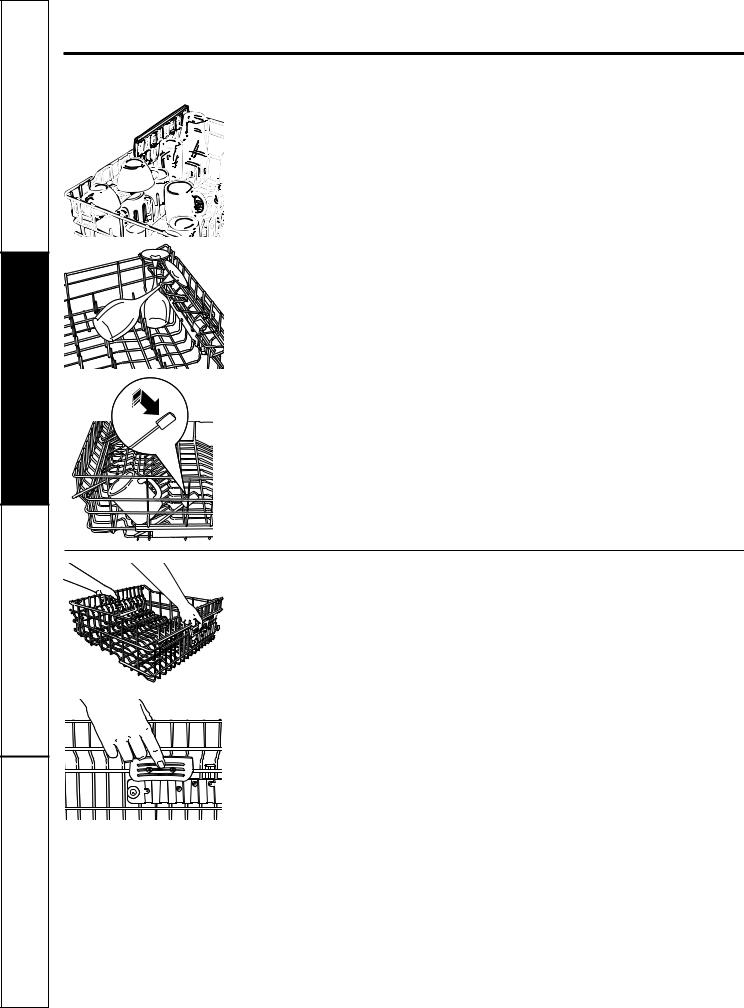
Safety Instructions
Operating Instructions
Troubleshooting Tips
Consumer Support
Loading the dishwasher racks.
For best dishwashing results, follow these loading guidelines. Features and appearance of racks and silverware baskets may vary from your model.
Upper Rack
Although the upper rack is primarily for glasses, cups and saucers, pots and pans can be placed in this rack for effective cleaning. Cups and glasses fit best along the sides. This is also a secure place for dishwasher plastics.
The utility shelf (some models) may be placed in the up or down position to add flexibility. A wine glass holder (some models) secures wine glasses for best washability.
Some models have contoured metal cup shelves that can secure up to 12 wine glasses (as shown).
Because wine glasses come in various sizes, after loading, slowly push in the rack to make sure they will clear the top of the dishwasher.
Some models have an Angled Rack System, which allows you to angle your dishes, such as coffee mugs, for better cleaning and quicker drying. To position the tines, pull the lever forward then drop the tines into position, then release the lever.
The upper rack is good for all kinds of odd-shaped utensils. Saucepans, mixing bowls and other items should be placed face down. Fold-down tines (on some models) provide flexibility for extra-large and hard- to-fit items.
Secure larger dishwasher-safe plastics over 2 tines when possible.
Make sure small plastic items are secure so they can’t fall onto the heater.
Be sure that items do not protrude through the bottom of the rack and block rotation of the middle spray arm. This could result in poor wash performance for items in the upper rack.
Check to make sure that no items will block rotation of the wash arm.
NOTE: The Single Rack Wash selection, on models with this feature, washes the upper rack only. If you use this feature, do not load items in the lower rack.
Adjustable Upper Rack (on some models)
The standard position of your adjustable rack is “up” which allows for maximum clearance for your taller items in the lower rack. If you have taller wine glasses, tumblers or other items to place in the upper rack, you may want to adjust the rack to the lower position.
To lower the rack, support the weight of the rack with your hands as shown and press both finger pads about 1/4″ toward the inside of the rack as indicated and guide the rack down to its lower position.
To raise the rack to the “up” position, pull up on the center of the rack side frame until the rack locks into place.
14
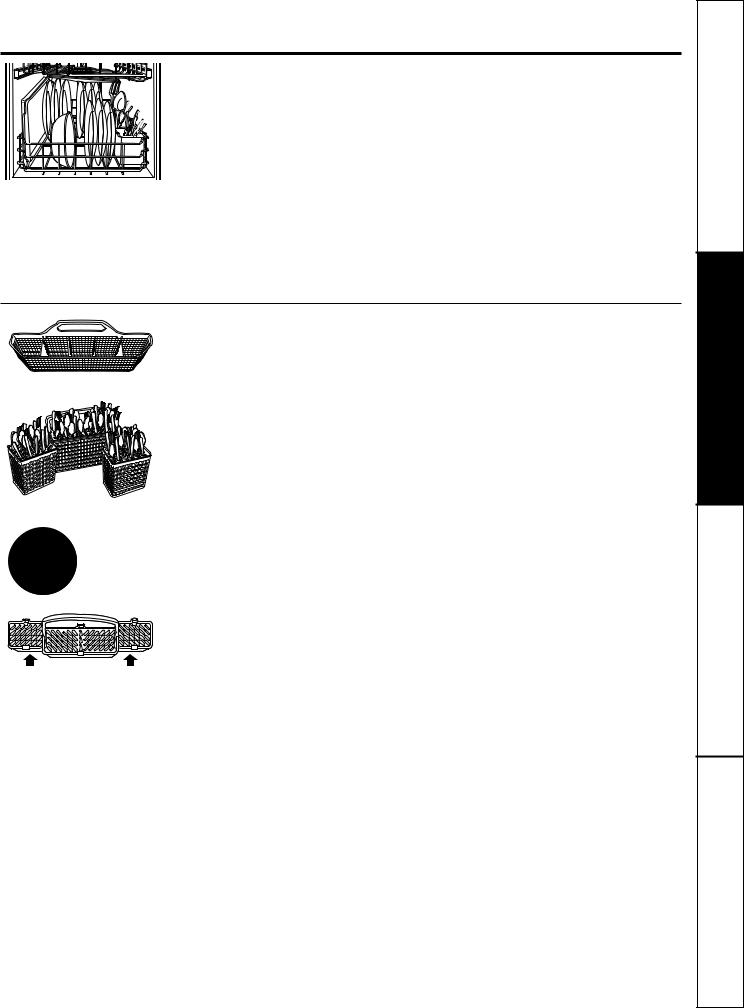
GEAppliances.com
Lower Rack
The lower rack is best used for plates, saucers and cookware. Large items such as broiler pans and baking racks should go along the left-hand side. Load platters, pots and bowls along the sides, in corners or in the back. The soiled side of items should face the center of the rack. If necessary, oversized glasses and mugs can be placed in the lower rack to maximize loading flexibility.
Also, be careful not to let a portion of an item such as a pot or dish handle extend through the bottom rack. This could block the wash arm and cause poor washing results.
Fold-down tines (on some models) provide flexibility for extra-large and hard-to-fit items. The tines may be left in the up position or folded down to customize the lower rack. Do not load large bowls or pots facedown in the front left-hand corner. Items loaded in this manner could prevent proper operation of the manual detergent cup.
One-piece basket (on some models)
Three-piece basket (on some models)
Don’t let any
item extend through bottom.
Silverware Basket
To load flatware, simply push the adjustable handle to either side (on some models). Put flatware in the removable basket with fork and knife handles up to protect your hands. Place spoons in the basket with handles down. Mix knives, forks and spoons so they don’t nest together. Distribute evenly. Small plastic items, such as measuring spoons and lids from small containers should go in the bottom of the silverware basket with the silverware on top.
The one-piece silverware basket (on some models) can be placed in the front, right side or back of the lower rack.
A variety of options is available regarding the three-piece silverware basket (on some models) in your dishwasher. The complete basket is designed to fit on the right side of the lower rack. Additionally, each end of the basket is removable to add loading flexibility to accommodate flatware and lower rack capacity needs.
The lids of both end and middle baskets (on some models) can be closed to contain small items. Long items can be placed on the utility shelf in the upper rack. Load flatware through the slots in the silverware basket covers.
To remove end baskets, grasp the basket at opposite corners and slide apart.
15
Instructions Safety
Instructions Operating
Tips Troubleshooting
Support Consumer
